|
< Earlier Kibitzing · PAGE 2 OF 2 ·
Later Kibitzing> |
| Jul-17-14 | | diagonalley: ... spent nearly 15 minutes trying (in vain!) to trap the white Q ... but eventually the potential of black's Q on QB1 dawned on me... seemed black could emerge a whole rook up, so didn't bother to look much beyond 19....Q-B6 ... i think that's worth a full credit |
|
| Jul-17-14 | | Nick46: Admirably conducted by Karjakin (and diagonalley). |
|
| Jul-17-14 | | Once: This is one of those puzzles which has more than one entrance. For me, it started with a bit of queen teasing. The white queen looks comically offside on h4. She is almost trapped. All we need to do is to find some peasants with pointy sticks to give her a very bad day. So 17...Ng6 has to be on the list. It forces 18. Qh5. Shame about that - we can't hit the white queen again. She is well and truly jammed in place, but not yet fatally wounded. 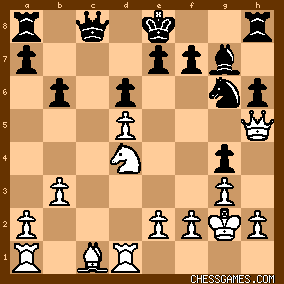
click for larger viewAt this point, the faint of heart might give up on the whole queen trapping idea. It hasn't worked. Time to look for something different. But there's a Thursday/Friday feeling that CG gives us. <Any series of forcing moves is almost by definition interesting, even if we can't immediately see why.> So we look a little deeper. Reset the puzzle to this position. We can force this position if we want, so this now becomes our starting position. Look again for a tactic. And that is when we notice the right angle triangle of Nd4, Ra1 and Rd1. Unexpected geometric shapes are important in chess - they sometimes point out combinations. From here we spot that 18...Bxd4 19. Rxd4 gives us this position ... 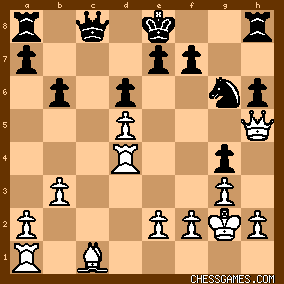
click for larger viewAnd we have another geometric pattern on the board - a straight line between Ra1 and Rd4. And a straight line is what we need for pins, skewers and (most) forks. 19...Qc3 picks up one of the two unprotected white rooks. The other way into this puzzle is to spot the potential for the Qc3 fork and work backwards from there. In order to be able to fork the rooks, we need to play Bxd4. And in order to be able to play Bxd4 we need to move the Ne5 out of the way. Can we move the knight with gain of time? Ah yes, 17...Ng6. |
|
| Jul-17-14 | | whiteshark: Cute tactics! |
|
| Jul-17-14 | | gofer: Well, this one looks like a queen trap, but I think its actually
a case of just winning a bishop and a pawn...
<17 ... Ng6>
<18 Qh5 Bxd4>
<19 Rxd4 Qc3!>
20 Bb2 Qxb2
21 Rdd1/Rad1 Qxe2 
~~~
White decided to give up a rook instead and win Pg4 and threaten
mate on c8! (Definitely better and more promising than the alternative
I thought of) But black just side-steps out of the mate threat and lays
his own diabolical trap - for the rather too obvious combination of Rc2
followed by Bb2 forking the R and Q. |
|
Jul-17-14
 | | Sneaky: I had the right idea but missed the stinger at the end of the scorpion's tale. I always have blindness to a queen forking two rooks. A bishop forking two rooks? That I'll spot in a heartbeat. But a queen? I miss it all the time. |
|
| Jul-17-14 | | Oxspawn: I didn’t get near this and to be honest it took me some time to see the knight fork and why white resigned, but I did get a kind of a result that cheered me up.
As Karjakin, I played
<17. h5>
which was not exciting but I have been waiting around for quite a while and Wang Yue has hardly moved a muscle. Looks like I am going to win on time…. Mind Games indeed. |
|
| Jul-17-14 | | Chess Dad: <I didn’t get near this and to be honest it took me some time to see the knight fork and why white resigned> Same here. I saw that the white queen was nearly trapped, but I couldn't find a way to turn "nearly" into "completely." And then at the ending position, I was looking for why white resigned. I fired up stockfish, and he told me. If white plays Rxb2, then black plays Ne5+ and wins the white queen with a fork. |
|
| Jul-17-14 | | patzer2: Black's final combination with 24...h3+!, with a deflection setting up an exchange of material and a winning Knight fork (i.e. after 26. Rxb2 Ne5+), is very similar to his first combination with the deflection 17...Ng6! leading to an exchange of material and a winning Queen fork. |
|
| Jul-17-14 | | Once: <Chess Dad> I don't think you need to see all the way to the end today. After 19...Qc3 and 20...Qxa1 black is a whole rook up. As long as he avoids white's mate threat he can win in a number of different ways. |
|
| Jul-17-14 | | JohnBoy: Right <FSR: Could be a Tuesday puzzle too after 24.Bb2.> - this is a gift that keeps giving. |
|
Jul-17-14
 | | OhioChessFan: I looked a long time for a Queen trap like many others. At the club level, White could have held out a while with 25. Qxh3 Rxh3 26. Bxa1 but at the GM level, this game was a disaster and Yue was surely happy for it to be over.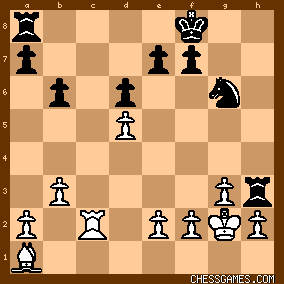
click for larger view |
|
Jul-17-14
 | | Penguincw: Wow. Looking at the Thursday puzzle, it looks impossible, but when you see the solution, it seems so obvious. |
|
| Jul-17-14 | | kevin86: Surprisingly, black will end a rook ahead. |
|
| Jul-17-14 | | jdc2: First tried to win R with Qc3, then tried to trap the queen with Bf6 or h5, didn't see the knight move, after seeing the solution it turns out to be a clearance problem. The knight vacates e5 with a forcing move so the bishop can use the diagonal. Clearance (and also interference) moves are sometimes hard to see. |
|
| Jul-17-14 | | awfulhangover: This was so easy that I thought I had missed something! |
|
| Jul-17-14 | | sombreronegro: 17 ... Ng6 discovers a pinned knight on d4 and attacks the queen which leads to a forcing move 18 Qh5 Nf4+ but it looks like h3 is covered , meaning sacking the knight to clear the 3rd rank looks to be dubious. Qc3 attacks the rook on a1 and the knight.... So I think 18 Qh5, Bxd4 19 Rxd4 hangs the two rooks for Qc3. Looks to me the only way to save them it so sac the bishop on b2. time to look...
OK about right but I was expecting 20 Bb2. Why 20 Rc4 I wonder preferring to save the bishop? |
|
| Jul-17-14 | | sombreronegro: wow nice finish...I guess the bishop fork was a hope but the royal fork on e5....ouch. |
|
Jul-17-14
 | | Jimfromprovidence: I saw the problem through 22 Rc2 but I did not see the pawn push coming. I thought black would play 22...Qe5, below, threatening 23...Qxd5+.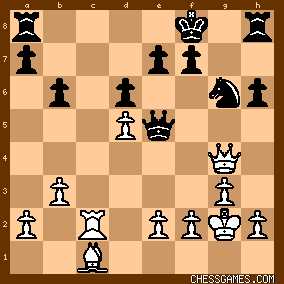
click for larger viewNotice the trap after 24 Bb2 below.
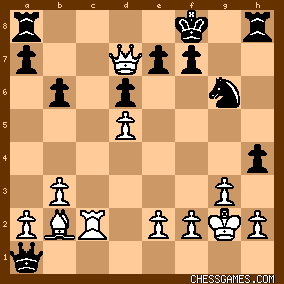
click for larger viewWhite wants to force black into 24...Qd1??, which is a mate in 2 for white. |
|
| Jul-17-14 | | Once: <Jimfromprovidence> The pawn push isn't essential. Black has plenty of other ways of avoiding the mate and converting his material plus. Frankly I was a little surprised that he left his queen on a1 for as long as he did. I would have wanted to retreat it to e5 or f6 much sooner to avoid any nasty Bb2 tricks. |
|
| Jul-17-14 | | ninja warrior: for once i disagree with you... at least regarding the pawn push to h3. it's obviously the strongest move, as it leads to the forced win of a piece. |
|
Jul-17-14
 | | Sally Simpson: Easy! Took less than a minute.
17....h5
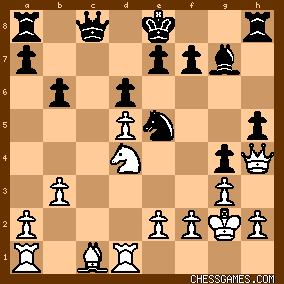
click for larger viewThreat Bf6 winning the Queen. White can ignore it because he has Bg5. So 18.Bd2 intending Rac1. 18...Bf6 19.Bg5 Ng6!
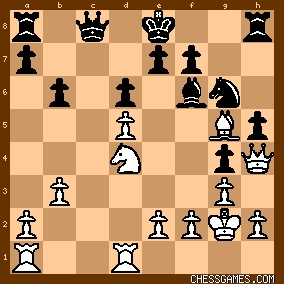
click for larger viewWhite can play Bxf6 and Bxh4. Getting two good bits for his Queen.
Some slight technical difficulties but nothing Karjakin should not be able to handle. Either Thursdays are getting easier or I'm getting better. OOPS! |
|
| Jul-17-14 | | TheBish: Wang Yue vs Karjakin, 2013 Black to play (17...?) "Medium"
Black wins with 17...Ng6 18. Qh5 Bxd4! 19. Rxd4 Qc3, when White can minimize the damage to loss of a bishop (instead of a rook) with 20. Bb2 Qxb2. |
|
| Jul-18-14 | | Once: <ninja warrior> Black makes three pawn moves after the main POTD combination - 22... h5, 23... h4 and 24...h3+. The third of these pawn moves is essential. It seems to be the only way for black to win. But the overall plan of h5-h4-h3 does not seem to be obligatory. After all, black is a rook up. He just needs to avoid being mated and he will win on material. A quick canter with Fritzie finds this:
After 22. Rc2, black has around ten moves which keep a healthy black advantage - including 22...h5. Six of these moves have an evaluation of -3.00 or more - ie worth more than 3 pawns. 22...h5 is the strongest move, but not by much. After 23. Qd7, black has a similar number of winning moves scoring more than -3.00, starting with Ne5, Qb1, f6, Qf6. 23...h4 is fifth on the list, scoring -2.67. By the time we get to 24. Bb2 (having played h5 and h4), we find that 24...h3+ is the only move that preserves a black advantage. That's why I am a little suspicious of the whole h5-h4-h3 plan. If I am a rook up I want to be simplifying the position. I don't want to be forced into a line where I need to find "only" moves. Incidentally, 24...h3+ does not lead to the forced win of a piece. It actually loses a pawn for black. Here's the position: 
click for larger viewFrom here, white should have played 25. Qxh3 Rxh3 26. Bxa1 
click for larger viewBlack should still win because he is still that rook ahead, but he is a pawn down compared to other lines. Overall, the pawn push of h5-h4-h3 wasn't essential. It wasn't even the best plan for black. Pragmatically, I suspect that many players would have looked for a way to bring their queen back into the action and neutralising the mate threat before pushing their h pawn. |
|
| Jul-18-14 | | Chris321: I also saw that the black queen could get a bishop an the epawn,instead of the a rook,if white could double his rooks on the dfile those rooks can later help protect his 2 first ranks as a defensive try )but this is clearly winning for black with a good couple of other variations too(after the Q captures the rook or bishop and epawn things will go downhill and the black kt will become dangerous an so on together with pawn pushes. |
|
 |
|
< Earlier Kibitzing · PAGE 2 OF 2 ·
Later Kibitzing> |





